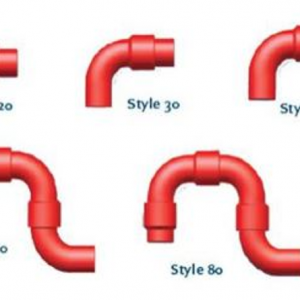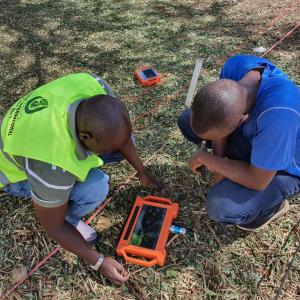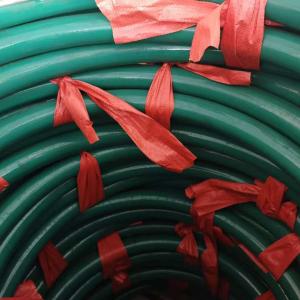Description
Mud Pump Pistons serve as the vital heart of high-efficiency drilling operations, functioning as precision reciprocating components that maintain critical hydraulic pressure and ensure continuous fluid circulation in demanding drilling environments. These specialized Pistons convert mechanical energy into hydraulic power through their axial movement within pump cylinders, creating the necessary pressure to drive drilling mud through the entire system
The piston assembly typically consists of a metallic core, elastomeric seals, and retention components that work in concert to:
In typical triplex pump configurations, pistons achieve 120-170 strokes per minute, with each complete cycle displacing 5-50 gallons of fluid depending on pump size and liner diameter. This rapid reciprocation demands exceptional material durability, with premium HNBR and polyurethane formulations demonstrating 3-5× longer service life than conventional nitrile rubber in sour gas environments (Wear Performance of Bionic Dimpled‐Shape Pistons).
Modern piston technology has evolved through three key generations:
Current industry standards like API 7K and ISO 14693 mandate rigorous testing protocols including:
As the primary moving interface between a pump’s power end and fluid end, pistons directly influence three critical performance metrics:
Field data from Norwegian offshore operations demonstrates how ceramic-coated pistons increased drilling efficiency by 9% while reducing unscheduled downtime (Mud Pump Liner and Piston Replacement: Best Practices Guide). Similar deployments in the Gulf of Mexico showed HNBR pistons doubling operational lifespan in H₂S-rich environments compared to conventional designs.
Modern mud pump pistons incorporate seven critical design features that collectively enhance drilling efficiency and reliability. These innovations address the extreme mechanical, thermal, and chemical challenges encountered in demanding drilling environments.
Advanced elastomers and hybrid materials define contemporary piston technology:
HNBR formulations demonstrate exceptional chemical resistance, withstanding H₂S concentrations up to 15,000 ppm in Middle Eastern sour gas fields (Mud Pump Liner and Piston Replacement: Best Practices Guide). Ceramic-metal composites reduce friction heat by 40% compared to traditional alloys, crucial for deepwater operations (泥浆泵凹槽形仿生活塞寿命试验及耐磨机理分析).
Modular piston architectures offer operational flexibility:
Field data shows replaceable designs cut maintenance time by 40% in Permian Basin shale operations (Bonded Urethane Pistons – Mud Pump).
API 7K-certified pistons withstand extreme conditions through:
Norwegian offshore deployments demonstrate 9% efficiency gains when using pistons meeting these specifications (Mud Pump Liner and Piston Replacement: Best Practices Guide).
Innovative surface treatments enhance durability:
Ceramic-coated pistons in the Gulf of Mexico doubled service life compared to conventional designs (10 Essential Mud Pump Spare Parts: A Comprehensive Guide …).
Dynamic sealing systems prevent leaks through:
These mechanisms maintain >92% volumetric efficiency even with 20% solids concentration (泥浆泵活塞皮碗).
Global interoperability is ensured through:
Manufacturers achieving both certifications report 60% fewer premature failures (10 Essential Mud Pump Spare Parts: A Comprehensive Guide …).
IoT-enabled pistons provide:
Field trials show 30% reduction in unplanned downtime through these systems (2025 Mud Pump Spare Parts Guide: Top 10 Components …).
The advanced features of modern mud pump pistons translate into measurable operational benefits across diverse drilling environments. Field applications demonstrate how material innovations and smart monitoring capabilities address specific challenges in offshore and deep-water operations, delivering efficiency gains and cost reductions.
Norwegian North Sea operations provide a compelling case for ceramic-coated pistons in high-intensity offshore environments. At the Johan Sverdrup field, operators achieved a 9% efficiency improvement after deploying third-generation ceramic hybrid pistons, with key performance metrics including:
The ceramic coating’s 60% wear reduction (Thermo–Solid Coupling Analysis of Bionic Piston for a Mud Pump in Tunnel Engineering) proved critical in handling abrasive drilling fluids containing 15-18% solids. Real-time IoT monitoring further enhanced reliability by predicting seal failures 48 hours in advance, reducing unplanned downtime by 30% (2025 Mud Pump Spare Parts Guide: Top 10 Components & Industry Trends).
Gulf of Mexico deployments highlight HNBR pistons’ superiority in H₂S-rich environments. In the Mars B development, HNBR formulations demonstrated:
The pistons’ dual-durometer sealing system prevented gas ingress during 7,500 psi pressure cycles, a critical factor in preventing blowouts (Mud Pump Liner and Piston Replacement: Best Practices Guide). Modular designs enabled 40% faster replacements during scheduled maintenance, with field crews completing swaps in under 90 minutes (10 Essential Mud Pump Spare Parts: A Comprehensive Guide).
These case studies demonstrate how advanced piston technologies collectively reduce downtime by 40-60% and operational costs by 15-20% through extended service life and predictive maintenance capabilities. The integration of durable materials, precision engineering, and smart monitoring creates a multiplier effect that transforms drilling efficiency in the most demanding environments.
Proper maintenance protocols are critical for maximizing the service life and operational efficiency of mud pump pistons. Implementing systematic inspection routines and timely interventions can prevent 60-70% of premature failures in high-pressure drilling environments (Mud Pump Common Failure Analysis And Troubleshooting).
Daily and weekly checks should follow a standardized procedure:
Critical weekly tasks include:
Diagnostic flow for prevalent piston issues:
Abrasive Wear Patterns
Seal Blowout
Fatigue Fractures
Proactive maintenance strategies can extend service life by 40-60%:
Core Functions and Operational Significance
Material and Design Evolution
Generation
Material Advancement
Typical Pressure Rating
Service Life
1st (1980s)
Nitrile Rubber
≤3,000 psi
150-300 hrs
2nd (2000s)
Polyurethane
5,000 psi
400-600 hrs
3rd (2020s)
HNBR/Ceramic Hybrid
7,500 psi
800-1,200 hrs
System Integration and Performance Impact
Key Features of High-Efficiency Mud Pump Pistons
Durable Material Composition
Material
Temperature Limit
Service Life
Ideal Environment
Polyurethane
80-110°C
400-600 hrs
Water-based muds
HNBR
150°C
800-1,200 hrs
Sour gas/H₂S environments
Ceramic Hybrid
300°C
1,500+ hrs
Geothermal/HPHT wells
Advanced Structural Design
High-Pressure Tolerance
Wear Resistance Technology
Technology
Wear Reduction
Application Case
Zirconia coating
60%
Gulf of Mexico deepwater drilling
Gradient composites
40%
Indonesian nickel laterite mines
Laser texturing
35%
Permian Basin fracking operations
Sealing Efficiency
Compatibility with Industry Standards
Smart Monitoring Capabilities
Applications and Performance Case Studies
Offshore Drilling Success
Parameter
Conventional Pistons
Ceramic-Coated Pistons
Improvement
Service Life
400 hours
1,200 hours
200%
Pressure Fluctuations
±500 psi
±150 psi
70% reduction
Maintenance Intervals
Weekly
Monthly
75% longer
Deep-Water Challenges
Maintenance and Troubleshooting
Routine Inspection Protocols
Check Type
Measurement Method
Acceptable Threshold
Corrective Action
Seal integrity
Visual inspection for mud leakage at alarm holes
<5mm weepage at gland seats
Replace HNBR/polyurethane seals if exceeding tolerance (泥浆泵日常维护保养表)
Wear measurement
Caliper measurement of piston diameter
≤0.5mm reduction from original size
Rotate or replace piston when exceeding 1mm wear (Routine maintenance and inspection of mud pump)
Surface cracks
Dye penetrant testing
No visible crack indications
Immediate replacement if cracks propagate >3mm longitudinally
Lubrication
Oil analysis for solid contamination
<3% solids by volume
Flush lubrication system and replace oil (10 Essential Mud Pump Spare Parts: A Comprehensive Guide)
Common Failure Modes
Preventive Measures
Inquiry Us





